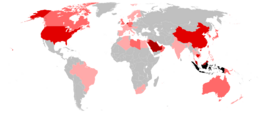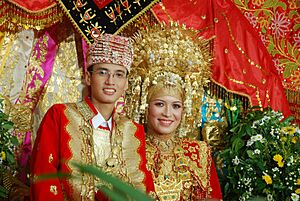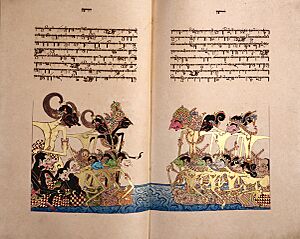Indonesians facts for kids
| Orang Indonesia | |
|---|---|
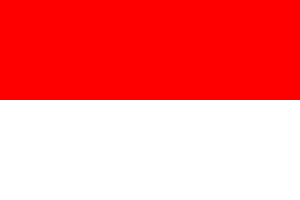
|
|
| Total population | |
c. 280.7 million 2023 civil registration estimate c. 270 million Indonesia 2020 census c. 237 million Indonesia 2010 census |
|
|
|
|
|
|
|
|
|
| 300,000 (assimilate into the local Cape Malays) | |
| 300,000 (2020) | |
| 200,000 (2019) | |
| 149,101 (2023) | |
| 155,713 (2022) | |
| 111,987 (2019) | |
| c. 87,000–92,400 (2021) (Indonesian-born) |
|
|
|
| 80,000 (2018) (excluding Indonesian ancestry) |
|
| 46,586 (2019) | |
| 43,871 | |
| 42,000 (2019) | |
| 40,148 (2014) (assimilate into the local Sri Lankan Malays) | |
| 38,000 (2020) (only Indonesian legal workers) |
|
| 37,669 (2019) | |
| 33,000 | |
| 28,954 (2020) | |
| 24,000 (2021) | |
| 21,390 (2016) | |
| 12,904 (2019) | |
| 11,000 | |
| 7,310 (2022) | |
| 7,000 | |
| 6,000 | |
| 4,300 | |
| 3,000-5,000 (See: Overseas Acehnese) | |
| 4,000 | |
| 3,000 | |
| 2,400 (2020) | |
| 2,000 | |
| Languages | |
| Indonesian Javanese • Sundanese • Madurese • Minangkabau • Buginese • Bataknese • Bantenese • Banjarese • Balinese • Acehnese • Philippine languages • Papuan languages • other languages |
|
| Religion | |
| Majority Islam 87.02% Minorities Christianity 10.49% (Protestantism 7.43% and Roman Catholicism 3.06%) · Hinduism 1.69% · Buddhism 0.73% · Confucianism 0.03% · Animism · Shamanism · Aliran Kepercayaan · Irreligious 0.04% (2022) |
|
| Related ethnic groups | |
| Filipinos • Malaysians | |
Indonesians (in Indonesian: orang Indonesia) are people who live in or are from the country of Indonesia. It doesn't matter what their family background or religion is. Indonesia is a huge country made up of many islands. It has over 1,300 different ethnic groups. This makes Indonesia a very diverse place with many languages, cultures, and religious beliefs.
In 2020, about 270.2 million people lived in Indonesia. More than half of them (56%) live on the island of Java. Java is the most populated island in the world! About 95% of Indonesians are native people. The largest groups are the Javanese (40%) and the Sundanese (15%). The other 5% of Indonesians have family roots from other countries. These include people with Arab, Chinese, Indian, and European backgrounds.
Contents
Population of Indonesia
Indonesia is the fourth most populated country in the world. Only China, India, and the United States have more people. In 2020, Indonesians made up about 3.4% of the world's total population.
Indonesia has a program to help families plan how many children they have. This program started in 1967 and has been quite successful. Even so, Indonesia's population grew by 1.1% between 2010 and 2020. If this growth continues, Indonesia could become the third most populated country by 2043. The family planning program is being updated to help manage this growth.
Life on Java Island
Java is home to 151.6 million people. This means 56% of Indonesia's population lives there. It is the most populated island on Earth. Jakarta, the capital city of Indonesia, is located on western Java.
Many important historical events happened on Java. It was once the center of powerful Hindu-Buddhist kingdoms. Later, Islamic sultanates ruled there. It was also the main part of the Dutch East Indies during colonial times. Java was very important in Indonesia's fight for independence in the 1930s and 1940s. Today, Java is still very important for Indonesia's politics, economy, and culture.
Other big islands in Indonesia include Sumatra, Kalimantan, Sulawesi, and New Guinea. These islands are home to the other 49% of Indonesians. There are also many smaller islands where people live. Some examples are Bali, Bangka, Madura, and the Maluku Islands.
Diverse Ethnic Groups
Indonesia has over 1,300 different ethnic groups. This makes it one of the most diverse countries in the world. About 95% of these groups are native to Indonesia.
The largest group is the Javanese. They make up almost 40% of all Indonesians. Most Javanese live on the island of Java. However, millions have moved to other islands. This happened because of a government program called the transmigration program. This program aimed to move people from crowded islands to less crowded ones.
The Sundanese are the second largest group, making up 15% of the population. They live mainly in the western part of Java. Other large groups include Malays, Batak, Madurese, Betawi, and Minangkabau. Some ethnic groups, especially in Kalimantan and Papua, have only a few hundred members.
Most local languages in Indonesia belong to the Austronesian language family. But some, especially in the Maluku Islands and Western New Guinea, are Papuan languages. People of Chinese descent make up less than 1% of Indonesia's population. Some of them speak different Chinese languages, like Hokkien and Hakka.
It can be tricky to classify ethnic groups in Indonesia. This is because people have moved around and influenced each other's cultures and languages. For example, some people think the Osing people and Cirebonese are part of the Javanese people. But others say they are separate groups because they have their own unique ways of speaking. The Baduy people are a sub-group of the Sundanese people. However, they are sometimes seen as their own distinct ethnic group.
The Betawi people are an example of a mixed ethnic group. Their ancestors came from different Indonesian groups. They also mixed with people from other countries like Arab, Chinese, and Indian migrants. This happened during the time when Jakarta was called Batavia under colonial rule.
Languages Spoken in Indonesia
Indonesian is the official language of Indonesia. It is a standard version of the Malay language. Malay has been used for hundreds of years as a common language in the Indonesian islands. Most Indonesians also speak one of the more than 700 local languages.
Besides the national language, most Indonesians can speak a regional language. These include Javanese and Sundanese. These languages are often used at home and in local communities. However, formal education, national news, and most communication happen in Indonesian.
In East Timor, which used to be part of Indonesia, Indonesian is still an important language. It is one of two working languages, along with English. The official languages there are Tetum and Portuguese.
Indonesian Literature
Indonesian literature refers to books and writings created in the Indonesian islands. It can also mean literature from areas where people speak languages related to Malay language. This includes Indonesia, but also countries like Malaysia and Brunei. It also includes Malay people living in places like Singapore.
There are also writings about Indonesia in other languages. Within Indonesia, there are several different literary traditions. For example, the island of Java has its own Javanese cultural and literary history. There are also Sundanese, Balinese, and Batak or Madurese traditions.
Indonesia has a history of being ruled by other countries, like the Dutch, British, and Japanese. These times brought new texts, languages, and literary styles. The influence of Islam also brought its own texts and literary ideas. Indonesia also has a rich tradition of oral literature, which means stories and poems passed down by speaking, not writing.
When we talk about "Indonesian literature," we usually mean writings in the Indonesian language. This also includes earlier forms of the Malay language written during the time of the Dutch East Indies.
Religions in Indonesia

Indonesia is a country where the government is separate from religion. However, the first rule of Indonesia's main philosophy, Pancasila, is "belief in the one and only God". Many different religions are practiced in Indonesia. These religions have a big impact on the country's politics, economy, and culture.
The Indonesian Constitution says that everyone has the freedom to choose their religion. But the government officially recognizes only six religions: Islam, Protestantism, Catholicism, Hinduism, Buddhism, and Confucianism. However, there are about 245 other non-official religions in Indonesia.
Indonesian law requires every citizen to have an identity card. This card usually shows one of the six recognized religions. If someone follows a different religion, they can write 'believer' or leave the section blank. Indonesia does not officially recognize agnosticism (not knowing if God exists) or atheism (not believing in God). It is also against the law to insult religions.
Indonesia has the largest Muslim population in the world. In 2018, about 86.7% of Indonesians said they were Muslim. Other religions include Protestant (7.6%), Catholic (3.12%), Hindu (1.74%), Buddhist (0.77%), and Confucianism (0.03%). A very small number (0.04%) follow other religions or no religion.
Indonesia's leaders have played a role in how different religious groups get along. They have promoted respect by supporting Pancasila. But some government programs, like the Transmigration Program, have sometimes caused disagreements in certain parts of the country.
Delicious Indonesian Cuisine

Indonesian food is known for being very colorful and full of strong flavors. It is very diverse because Indonesia has about 6,000 islands where people live. There are also more than 1,300 ethnic groups. Each region often has its own unique dishes. These dishes are influenced by local culture and ideas from other countries. Indonesia has around 5,350 traditional recipes. About 30 of these are considered the most important.
Indonesian food is very different from one region to another. For example, food from Sumatra often has influences from the Middle East and India. You might find curried meats and vegetables like gulai and kari. On the other hand, Javanese cuisine or Sundanese cuisine is mostly native to Indonesia. It has only a few hints of Chinese influence. The food in Eastern Indonesia is similar to Polynesian and Melanesian food.
You can also see elements of Chinese cooking in Indonesian food. Dishes like bakmi (noodles), bakso (meat or fish balls), and lumpia (spring rolls) have become fully part of Indonesian cuisine.
Indonesian Architecture Styles
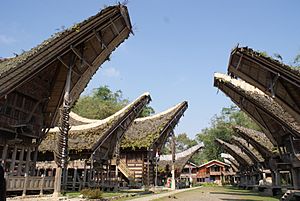
Indonesian architecture shows how many different cultures, histories, and places have shaped the country. People who came to Indonesia, like invaders, colonizers, missionaries, and traders, brought new ideas. These ideas greatly changed how buildings were designed and built.
Historically, the biggest foreign influence came from India. But Chinese, Arab, and European styles have also been very important in shaping Indonesian architecture. Religious buildings include traditional forms, mosques, temples, and churches. Rulers and sultans built grand palaces. Many old buildings from the colonial period can still be seen in Indonesian cities. After Indonesia became independent, new modern and contemporary building styles also developed.
See also
- List of Indonesian people
- Native Indonesians
- Ethnic groups in Indonesia
- Overseas Indonesians
- Culture of Indonesia
- Non-native Indonesians
- African Indonesians
- Arab Indonesians
- Chinese Indonesians
- Filipino Indonesians
- Indian Indonesians
- Indo people (mixed European-Indonesians)
- Jewish Indonesians
- Pakistani Indonesians
- Totok (Dutch Indonesians)


